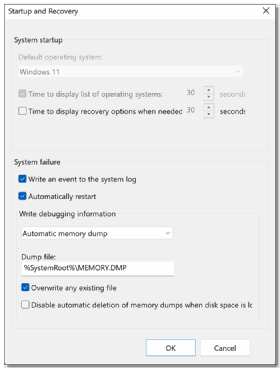
Getty Images/iStockphoto
How to fix Windows 11 when it keeps restarting
When a Windows 11 desktop keeps restarting, there are a few factors that may be behind the issue. IT administrators should understand all the possible causes and how to solve them.
Windows 11 desktops can get stuck in a reboot loop that makes it impossible for users to work, and sometimes it's unclear why the problem occurs or how to fix it.
This can hinder productivity to the point that users experiencing a reboot loop must find another machine to work on until IT can solve the problem. Users may lose unsaved work or files and have to work on a desktop or other device that isn't optimized for their preferences and needs.
A failed update, faulty hardware, new application or any number of other issues may cause Windows 11 to keep restarting. As an IT administrator, you may have to try many different strategies when troubleshooting a restart issue.
Why Windows 11 keeps restarting
It can be difficult to track down the underlying root causes of a reboot issue, especially if the problem occurs on some managed computers and not others. You should consider a wide range of possibilities during the troubleshooting process, including the following:
- Improper group policy settings. If admins have misconfigured group policies or failed to properly update them, a system may experience reboot issues.
- Inappropriate system settings. A few system configuration settings can cause a Windows 11 computer to keep restarting. For example, reboot problems can occur if users are overly aggressive with the power management settings or disable the secure boot function. Automatic restarts and fast startups, which are enabled by default, can also cause reboot issues.
- System instability. Problems at the system level, such as missing or corrupt OS files, can cause problems. Third-party applications can sometimes lead to reboot issues as well, especially if users installed or updated them recently. Even a Windows update can potentially cause restart problems, as can upgrading from Windows 10 to Windows 11.
- Malfunctioning hardware. Hardware drivers and peripheral devices can create restart issues. Potential causes include failing storage devices -- especially if they impact OS or application files -- and hardware overheating, which often worsens with high-intensity workloads.
- Malware infection. A malware infection may cause a computer to keep restarting. A reboot problem can even be one of the only signs that malware has infected a computer.
There can be other sources for the issue as well, but these common causes give admins a few places to start when up against reboot problems. The causes are not necessarily mutually exclusive, however. Multiple factors might contribute to a Windows 11 reboot loop.
What to do if Windows 11 keeps restarting
Because there are so many possible reasons why Windows 11 keeps restarting, there are also many steps admins can take to resolve reboot issues. You should look at three broad areas to identify the source of the problem: software environment, hardware environment and system settings. By assessing the desktop through these three categories, you can determine what the best way to solve the issue is -- whether that is pausing updates, replacing the local drive or changing group policy settings, for example.
Whether trying to address reboot issues directly or working with a user remotely, you should understand how to use Windows 11 safe mode to access the Windows system -- especially if the restart issue prevents the user from booting normally into the computer. Safe mode is a diagnostic and troubleshooting operating environment that runs a pared-down version of the OS to help isolate and identify system issues.
Safe mode runs Windows 11 in a basic state that operates with a limited set of files, drivers, services and features. You can use safe mode to carry out several tasks, such as updating drivers, removing hardware components, uninstalling new applications or scanning for malware -- all of which may cause Windows 11 to keep restarting.
Assess the software environment
When troubleshooting reboot issues in Windows 11, you should look closely at the software environment. There is no single approach to take with software-related issues, and it will likely come down to some trial and error to discover the underlying cause. In some situations, though, the problem may be readily apparent. For example, it might have started right after applying a Windows update or installing a new application.
If the cause isn't clear, a good place to start is with Windows Update. Even if you centrally control updates on managed desktops, you might still need to assess an individual computer to determine whether a specific update has been properly installed. If you access the managed computer directly, you can check for updates or view the update history through the Windows Update feature in Settings (Figure 1).

Here, you can see if an update failed. If it did, check whether any temporary files have been left behind in the software distribution folder. You might need to delete the files before trying to run the update again.
In some cases, a successful update still appears to be the root of the reboot problem. If this occurred, you can uninstall the update through the Update history utility. If the computer then boots up normally, this at least helps get the computer operational while giving you more time to figure out why the update might be causing problems.
You can also consider placing controls on when your organization's managed Windows 11 computers should restart after an update. For this, you can use group policy settings or a mobile device management (MDM) tool to set restart policies that will take effect after an update.
Temporarily deferring updates may also help resolve startup issues. Under Windows Update, users have the option to pause updates for up to three weeks.
Another option for addressing reboot issues is to restore the computer to a specific point in time. This is only possible if Windows has automatically created restore points on the system or if IT has done so manually. When working on an individual computer, you can use the System Restore utility to revert the system to a specific restore point.
If you suspect that a recently installed application might be causing the reboot problem, uninstalling the application and rebooting the computer may address the issue. If working directly on the computer, you can use the Apps & features screen to uninstall the suspected application (Figure 2).

Consider using the Deployment Image Servicing and Management (DISM) tool and the System File Checker (SFC) to scan the Windows 11 computer as well. The DISM scan should run before the SFC scan. Together, these tools allow IT to identify and replace missing or corrupted Windows 11 system files. However, it's important to fully understand how these tools work before running either type of scan.
You should also scan the computer for malware, which can lead to reboot issues and result in even more serious consequences. The approach IT teams take here will depend on how they've implemented security protection on their networks and desktops.
Another software-related option for addressing reboot issues is to reset Windows, which returns the OS to its original factory settings. To do this, navigate to Start > Settings > System > Recovery. After selecting Reset this PC, you can choose whether or not to retain personal files (Figure 3). In either case, you should back up the files before resetting Windows.

You should not reset Windows until you've tried all other options, including those related to hardware and system settings. If resetting Windows doesn't work, you may need to reinstall the OS, effectively starting from scratch.
Assess the hardware environment
As with the software environment, you should evaluate the computer's hardware to determine whether it's part of the reason why Windows 11 keeps restarting. One possible culprit is a hardware driver, which can become corrupted or outdated. An administrator working directly on a Windows 11 PC can use the Device Manager to update drivers or remove a device that might be causing issues.
In addition to the drivers, you should test other aspects of the hardware. For example, a peripheral device might be causing the reboot problem. For this reason, it's a good idea to unplug external devices when troubleshooting a system. You should also monitor hardware components -- particularly CPUs and graphic cards -- for signs of overheating. Overheating can cause a system to continuously restart, attempting to avoid any damage to the hardware.
You should also run diagnostics against the power supply to ensure that it is delivering sufficient voltage to the computer and operating within recommended parameters. Additionally, make sure to verify that there are no problems with the local drive that might be causing random restarts. To do this, you can use the CHKDSK (check disk) utility to check the file system and the volume's metadata for logical and physical errors.
The CHKDSK utility locates bad sectors and physical disk errors and attempts to recover readable information, which might include data that the OS is trying to access. In some cases, running a scan to check for errors can resolve reboot issues. However, if bad sectors are behind the problem, it might be time to replace the drive.
Assess the system settings
The computer's system configuration settings can sometimes lead to continuous restarts. For example, misconfigured group policies can cause reboot issues. So can policies that are not properly updated, which can occur when updating Windows or migrating from Windows 10 to Windows 11. IT must properly configure and update group policies on managed computers as necessary.
A Windows 11 computer can also run into reboot issues if secure boot has been disabled for any reason, which is possible even if it is a system requirement. You can verify whether secure boot is enabled through the system summary available in the System Information app (Figure 4). The Secure Boot State feature should be set to On. If it's not, you will need to update the Unified Extensible Firmware Interface (UEFI) settings.

Another troubleshooting option is to disable the automatic restart feature on the Startup and Recovery screen (Figure 5). The Automatically restart option is enabled by default, so restart issues might occur, no matter what the underlying problem is, making it difficult to diagnose. If you disable this feature, the computer might instead display an error message or perform some other behavior that can help isolate the problem.

You might also consider disabling fast startup, which enables Windows to boot up more quickly after the computer shuts down. This feature can sometimes cause issues, including repeated bootups. By disabling it, you can at least determine whether this might be part of the problem.
Additionally, check whether users have configured overclocking on any of the hardware. If so, you should disable it. On laptop computers, you should review the power management settings, particularly as they pertain to the battery. In some cases, such as when performing resource-intensive operations, the power options might be causing the reboot issue.
When reviewing the configuration settings, you should make one change at a time and check whether it makes a difference. If not, revert the setting to its original configuration and move on to another strategy. You can also choose to check system settings before focusing on the software or hardware. It depends on the circumstances and what seems to be the most likely source of the problem.







